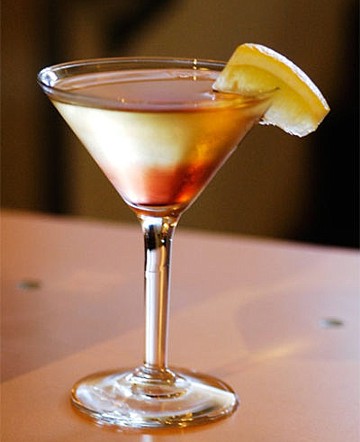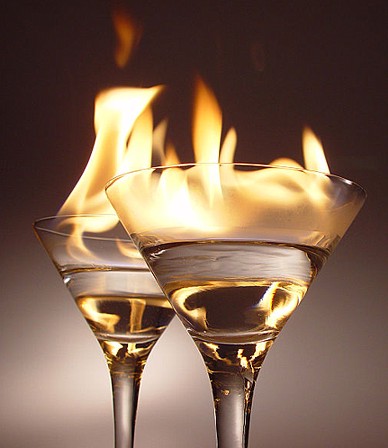Lessico
Coktail
Coda di gallo

L'etimologia del termine cocktail, attestato per la prima volta nel 1806, non è chiara. Esistono tuttavia diverse ipotesi sulla sua origine:
- potrebbe derivare dai termini inglesi cock (gallo) e tail (coda), forse dovuto al fatto che verso il 1400 nelle campagne inglesi si beveva una bevanda variopinta ispirata ai colori della coda del gallo da combattimento;
- potrebbe derivare dal termine francese coquetier - pronunciato cocktay in inglese, un portauovo che sin dal 1795 veniva usato a New Orleans dal farmacista Antoine Amédée Peychaud per servire liquori;
- potrebbe essere una distorsione dal latino [aqua] decocta, cioè acqua distillata;
- potrebbe derivare dalla leggenda che narra di una nave di ricchi inglesi che, approdando in Sud America, festeggiavano bevendo liquori europei e succhi tropicali che venivano mescolati servendosi di una colorata piuma di gallo.
Circa l'etimologia della parola cocktail, curiosa è una puntata della serie animata giapponese Detective Conan: in tale lunghissima serie (se ne contano ormai più di 500 episodi) il protagonista è un perspicace investigatore che ritorna bambino causa l'ingestione di una pozione. Egli risolve i casi più disparati e talvolta, quando l'effetto della pozione svanisce temporaneamente, riesce a farlo anche sotto le sue spoglie abituali di adulto.
Il detective Conan
Il cocktail è un aperitivo di origine americana costituito da una mescolanza di diverse bevande alcoliche nelle precise proporzioni indicate da una ricetta. Ormai diffuso in tutto il mondo, le sue ricette più classiche partono da una base molto alcolica (generalmente gin o whisky), alla quale si aggiungono vermouth, amari o altri liquori. La miscela viene poi mescolata o sbattuta con ghiaccio, usando rispettivamente o l'apposito bicchiere o lo shaker.
Un cocktail pur essendo in genere una miscela di diversi liquori, lo si ottiene anche con l'eventuale aggiunta di altri ingredienti come zucchero, frutta, ghiaccio, bevande non alcoliche. Per estensione, vengono chiamati cocktail anche bevande non alcoliche ottenute dalla miscela di diversi ingredienti (cocktail analcolico).
La parola cocktail appare per la prima volta nell'edizione del 16 maggio 1806 del Balance and Columbian Repository che ne dava la seguente definizione: «"Cocktail" is a stimulating liquor composed of spirits of any kind, sugar, water, and bitters. » «Il "Cocktail" è una bevanda stimolante, composta di diverse sostanze alcoliche alle quali viene aggiunto dello zucchero, dell'acqua e dell'amaro. »
La prima pubblicazione di una guida che includesse ricette di cocktail è del 1862: How to Mix Drinks; or, The Bon Vivant's Companion, del professor Jerry Thomas. Oltre alla lista delle solite bevande con mix di liquori, vi erano scritte 10 ricette che erano chiamate "Cocktails". L'ingrediente che differenziava i "cocktails" dalle altre bevande in questo compendio era l'uso degli amari, anche se questo tipo di ingrediente non si trova oramai quasi più nelle ricette moderne.
Negli Stati Uniti durante il Proibizionismo (1919-1933), quando il consumo di alcool era illegale, i cocktail erano comunque bevuti negli "speakeasies". Durante questo periodo la qualità dei liquori era scadente rispetto ai periodi precedenti e per questo motivo i baristi tendevano a mescolare i liquori con altri ingredienti. Proprio durante questo periodo si fanno risalire le prime vere raccolte di ricette per cocktail dell'era moderna, soprattutto in Europa, con le 900 Recettes de cocktail di Torelli nel 1927 a cura di Torelli (un barman di Parigi) e il The Sailoy Cocktail inglese del 1931. Anche cinema e letteratura hanno contribuito al successo dei cocktail.
Grazie
al Fascismo
un cocktail diventa una coda di gallo
Achille Starace (Sannicola LE, 18 agosto 1889 – Milano, 29 aprile 1945) è stato un militare, politico e dirigente sportivo italiano. È stato per otto anni (dal 1931 al 1939) segretario del Partito Nazionale Fascista, presidente del Comitato Olimpico Nazionale Italiano, commissario straordinario della Lega navale italiana, luogotenente generale della Milizia volontaria per la sicurezza nazionale.
Starace promosse inoltre una campagna per l'italianizzazione dei termini stranieri di uso comune. Tramite un concorso pubblico furono trovati termini di successo quali «tramezzino» per sandwich, «autorimessa» per garage, «pallavolo» per volley. A parte recuperare il termine «pallacorda» per il tennis, altre soluzioni furono infelici o di nessun mordente, quali «mescita» per bar (usato però oggi ancora come definizione di bevanda "sciolta" o al bicchiere), «coda di gallo» per il cocktail, «cialdino» per cachet, «arzente» per cognac. In una campagna di divieto della musica d'oltreoceano, il brano musicale St. Louis Blues dovette essere inciso dal cantante genovese Natalino Otto con il titolo «Le tristezze di San Luigi», mentre diversi personaggi dello spettacolo (come Renato Rascel o Wanda Osiris) dovettero modificare il proprio nome d'arte. Achille Starace pensava di "rendere più fascista" la vita quotidiana degli italiani nel corso degli anni '30.
Ben presto Starace divenne bersaglio delle canzonature popolari. Nei suoi tempi fu noto un "bestiario fascista" che comprenderebbe "l'aquila, che è rapace; la lupa, che è vorace; l'oca, che è Starace". Per la sua cieca devozione a Mussolini, fu chiamaro Claretto Petacci. Anzi, dopo la sua scomparsa, si diceva che era stato sepolto sotto una crudele epigrafe: Qui giace Starace / vestito di orbace, / di nulla capace. / Requiescat in pace.

Cocktail flambé
A cocktail is a mixed drink containing two or more ingredients. Originally a mixture of distilled spirits, sugar, water, and bitters, the word has gradually come to mean almost any mixed drink containing alcohol. A cocktail today usually contains one or more types of liquor and one or more mixers, such as bitters, fruit juice, fruit, soda, ice, sugar, honey, milk, cream, or herbs.
The earliest definition of cocktail was in the May 16, 1806, edition of the Balance and Columbian Repository, a publication in Hudson, New York, in which an answer was provided to the question, "What is a cocktail?". It replied: “Cocktail is a stimulating liquor composed of spirits of any kind, sugar, water, and bitters — it is vulgarly called a bittered sling and is supposed to be an excellent electioneering potion, inasmuch as it renders the heart stout and bold, at the same time that it fuddles the head. It is said, also to be of great use to a Democratic candidate: because a person, having swallowed a glass of it, is ready to swallow anything else.”
The first publication of a bartenders' guide which included cocktail recipes was in 1862 — How to Mix Drinks; or, The Bon Vivant's Companion, by "Professor" Jerry Thomas. In addition to listings of recipes for Punches, Sours, Slings, Cobblers, Shrubs, Toddies, Flips, and a variety of other types of mixed drinks were 10 recipes for drinks referred to as "Cocktails". A key ingredient which differentiated "cocktails" from other drinks in this compendium was the use of bitters as an ingredient, although it is not used in many modern cocktail recipes. The first "cocktail party" ever thrown was allegedly by Mrs. Julius S. Walsh Jr. of St. Louis, Missouri, in May 1917. Mrs. Walsh invited 50 guests to her home at noon on a Sunday. The party lasted an hour, until lunch was served at 1 pm. The site of this first cocktail party still stands. In 1924, the Roman Catholic Archdiocese of St. Louis bought the Walsh mansion at 4510 Lindell Boulevard, and it has served as the local archbishop's residence ever since.
During Prohibition in the United States (1920–1933), when the sale of alcoholic beverages was illegal, cocktails were still consumed illegally in establishments known as speakeasies. The quality of the alcohol available was far lower than was previously used, and bartenders generally put forth less effort in preparing the cocktails. There was a shift from whiskey to gin, which does not require aging and is thus easier to produce illicitly. Cocktails became less popular in the late 1960s and 1970s, as other recreational drugs became common. In the 1980s cocktails again became popular, with vodka often substituted for gin in drinks such as the martini. Traditional cocktails and gin are starting to make a comeback in the 2000s.
There are several claims about the origin of the term "cocktail," many of which are fanciful and few of which are supported by documentary evidence. Among them are:
- A tavern near Elmsford, New York was popular with the officers of the Revolutionary soldiers of Washington and Lafayette. The American troops preferred whiskey or gin, the French preferred wine or vermouth. All enjoyed a bit of brandy or rum. Sometimes late in the evenings, in a spirit of camaraderie, the spirits were mixed from one cup to another during toasts. A soldier stole a rooster from the tavern owner's neighbor, who was believed to be a Tory supporter of George III of the United Kingdom. The rooster was promptly cooked and served to the customers, with the tail feathers used to adorn the accompanying drinks. The toasts accompanying this meal were "vive le cocktail" and the mixed drinks were so called ever after.
- Another etymology is that the term is derived from coquetier, a French double-ended egg-cup which was used to serve the beverage in New Orleans in the early 19th century.
The word "cocktail" is sometimes used figuratively for a mixture of liquids or other substances. For example, the usage of such a word could be as follows: "120 years of industry have dosed the area's soil with a noxious cocktail of heavy metals and chemical contaminants". A makeshift incendiary bomb consisting of a bottle of inflammable liquid (usually gasoline) with a flaming rag attached is known as a "Molotov cocktail."